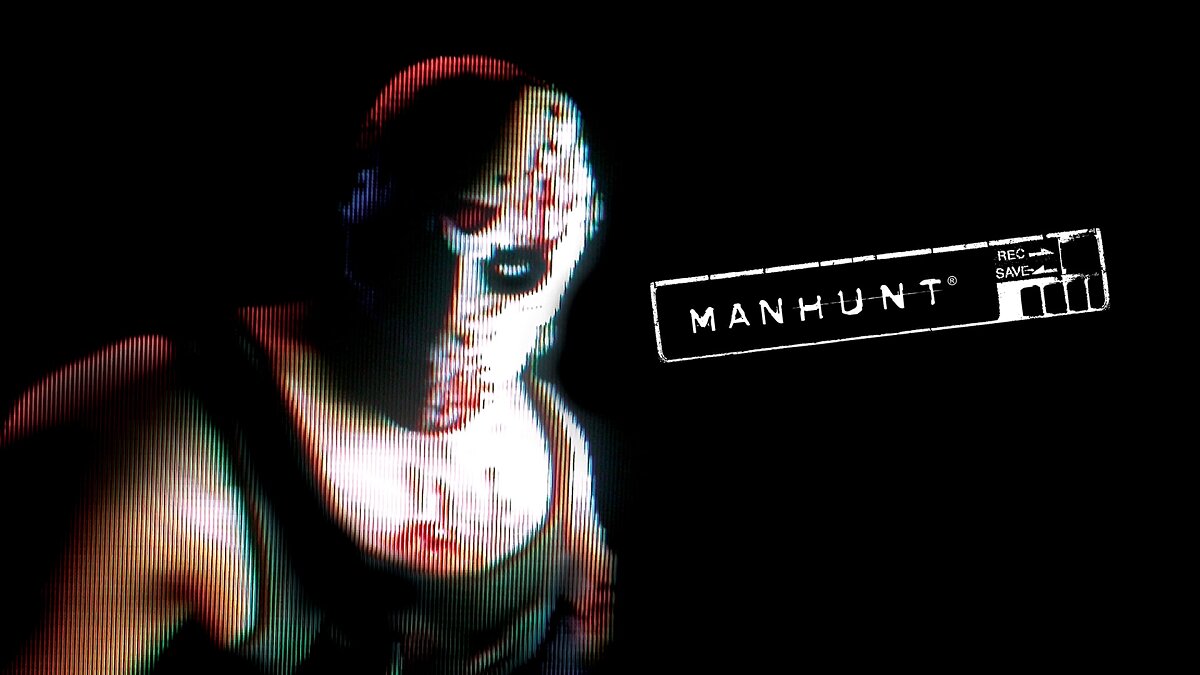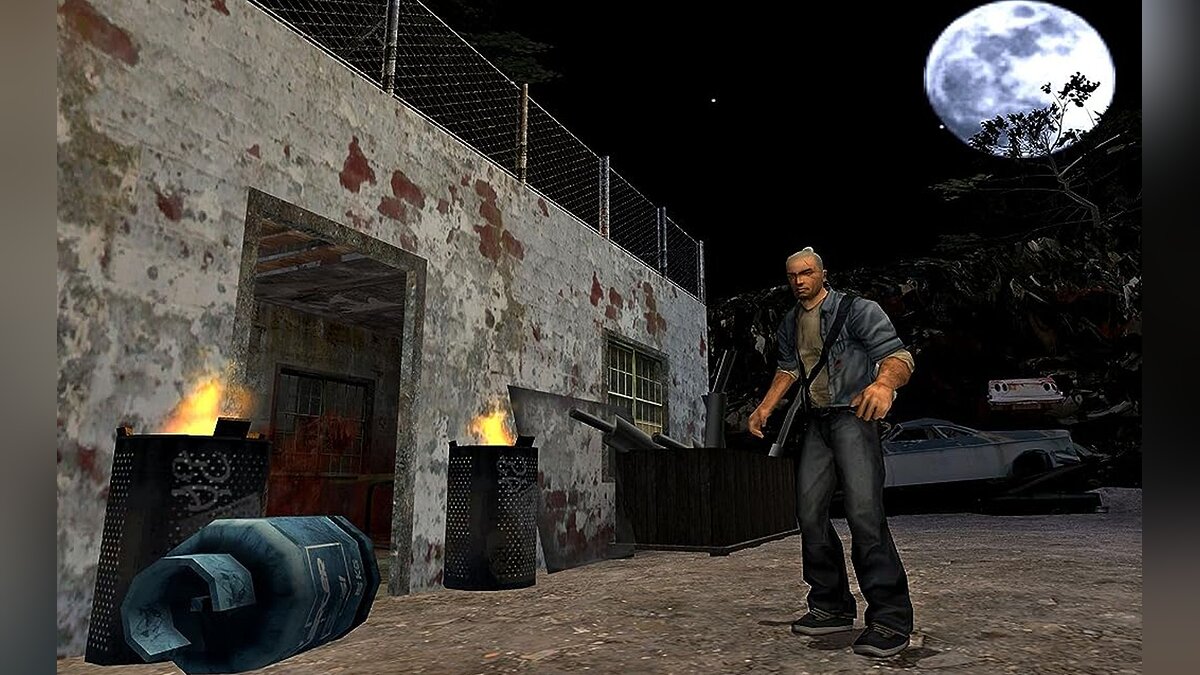Manhunt
In 2003, video games reached the pinnacle of cruelty. Rockstar's Manhunt was a response to the public noise surrounding violence in GTA 3. Even 20 years later, you won't find a game that so uncompromisingly puts merciless reprisals on virtual dummies under the lens. Contrary to stereotypes, Manhunt is not a game about "mindless killings". Like a gladiator in an ancient arena, the player must turn each murder into a spectacle, and the bloodier and cruelly he does it, the higher the result for the Director who orchestrated these games.
Distinctive Narrative Delivery Features
Manhunt rightfully earns its distinction as a unique game due to its unparalleled presentation of events. Instead of using expensive CGI sequences or complex mockup productions on the engine, Rockstar chose to portray all key events and character actions through recordings from surveillance cameras, ostensibly situated throughout the game world.
This approach has a significant impact on what is happening and mainly contributes to establishing the game's atmosphere. The player is unambiguously made aware that each action, stealthy attack, or firearm shooting is captured by the cameras. This explains the shifts in camera angles from the in-game camera during executions, intentionally capturing the bloodiest and most spectacular moments.
The player only needs to choose the right moment for an attack, while the game handles all the "dirty work" through various algorithms — there are no quick-time events (QTEs) or tedious combinations. The "tape" also absorbs many ordinary actions — protagonist movements, dialogues with characters, and the activity of enemies. The sensation of presence is heightened through the overlay of characteristic VHS-era artifacts on the video footage, evoking the playback technology of that era.
The revelation that the character is under close observation shatters the psychological barrier within the gamer's perception of the game. This is because the player associates the shifting camera angles not with the developers' intentions but with the wild imagination of a local Director. Additionally, players feel a sense of pursuit and an accompanying indescribable feeling of authenticity in the events. In the end, viewing oneself from the perspective of an ordinary viewer who is fed bloody content allows for an even deeper immersion into the role and the game world.
Connection Between GTA and Manhunt
Unleashed in 2001, GTA 3 came under criticism from both the public and the media because of the possibility of shamelessly creating violence on the streets of prosperous US cities and engaging in illegal activities. Passions were boiling regarding the influence of such games on youth and society at large. Manhunt provided an opportunity to observe cruelty and violence in an even more outrageous and terrifying context, thereby isolating Grand Theft Auto from such outbursts in the future.
Whether this was a deliberate plan or fate decreed is hard to say. However, the critique of brutality in Rockstar games tapered off after Manhunt. However, there are Easter eggs and references that indicate both series exist in the same universe:
- The place of action, Carcer City, is officially located in the fictional Liberty State, which is also home to Liberty City. A range of decorations, cars, weapons, and architectural elements appear in both games;
- Carcer City is mentioned several times in GTA 3, serving as the basis for game content in Manhunt. In GTA 4 and GTA 5, Carcer City and the game events are mentioned just a few times;
- In Manhunt, the advertising of Ammu-Nation, Burger Shot, and Cluckin' Bell, which are part of the GTA game universe, catches the eye;
- In the police station of Las Venturas in GTA: San Andreas, several posters are hung, displaying wanted members of The Hoods gang;
- The antagonist of Manhunt, Lionel Starkweather is a once-famous director from Vinewood, one of the districts of Los Santos (GTA: SA, GTA 5).
Background of Events
2003. Obsessed with the desire to create a reality show in the horror genre, the deviant and sadistic Lionel Starkweather takes control of the fictional Carcer City. He assumes custody of local psychopaths, gang members, mercenaries, and the police force. Over time, he transforms the city into an arena for "survival games," with observing violence and death becoming his favorite pastime.
Carcer City is a caricature of the American Rust Belt. Once a thriving industrial hub, it rapidly turned into the most depressed city in the state due to economic decline. Many of its districts descended into a chaotic anarchy with rampant crime. Five gangs of varying degrees of ruthlessness divided the city's territory. Mercenaries from Cerberus are supervising them. They also provide the filming process for Starkweather.
Unlike GTA, Manhunt doesn't feature an open world, but rather a set of levels of different sizes, designs, and degrees of freedom. The "gut-like" corridors shift to a more spacious, but still linear area, and then alternate with open spaces offering some freedom of action. Each location, including a prison, zoo, shopping complex, chemical plant, and business center, possesses a unique level of design, architecture, and interior details.
Plot
Manhunt begins with the execution scene of the protagonist, James Earl Cash, a skilled hitman and cunning criminal. After receiving a lethal injection, Cash blacks out but unexpectedly wakes up in Carcer City. The Director appears and tells that he saved James. Not out of nobility but to turn him into a new killing machine for his bloody show. Cash is promised freedom, and all he needs to do is kill.
The player is then presented with a straightforward tale of lesser evil (Cash) resisting the greater (Starkweather). Skipping his chatter, you can completely miss the plot of Manhunt because there is practically no explicit information. Nevertheless, the scriptwriters tackled questions about the need for a chance for redemption and how to wield it and addressed the moral decay of the wealthy and famous people.
Instead of using diaries, notes, or reflections of the main character, the creators rely on posters and graffiti, audio recordings, and dialogues — Cash's muteness doesn't hinder communication with other voiced characters. By exploring the environment, noticing details, analyzing them, and piecing together the puzzle, each player can interpret the plot in their way.
Gameplay
The Manhunt walkthrough is linear from beginning to finish, built on methodically killing enemies who gradually become stronger and more dangerous. The game starts as a stealth action, where the protagonist uses available means at hand, like plastic bags, to deal with enemies. By the finale, everything changes, and enemies attack the player in droves. Occasionally, for plot advancement, you need to sneak somewhere, acquire something, or help someone.
Tactical cunning becomes necessary with more and well-armed enemies. Distracting attention, separating enemies to the sides, maneuvering, and ambushing in the darkness become essential strategies. Sitting in the bushes for a long time to make one accurate strike is necessary frequently. All murders correspond to a certain degree of cruelty, and the player receives rewards — the more cruelly he deals with opponents, the more points he gets.
Weapons in Manhunt are divided in a non-standard way. Light ones, like plastic bags, wire, and glass shards, vanish after use but can provide one-strike kills. Such "medium" weaponry like clubs, knives, chainsaws, or handguns are reusable and more powerful. Heavy armaments like bats, shotguns, and rifles offer maximum damage but only appear in the second third of the game. There is also a gradation according to the degree of noise — from silent to very noisy and attracting attention.
The protagonist has two attributes: health and endurance. The first is self-explanatory, and the endurance consumed while running and a long fight prevents the game from becoming a full-fledged fighting game.
There is no system for character leveling in Manhunt. But level completion is rated in stars — ranging from 1 to 5 — based on the number and spectacle of executions, as well as the time spent on the level. As a reward, players gain access to the game's secrets and bonus missions.
















